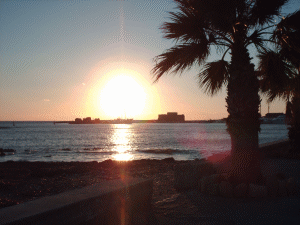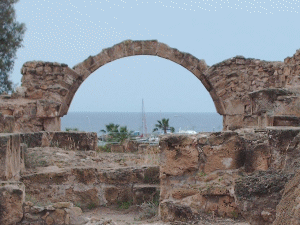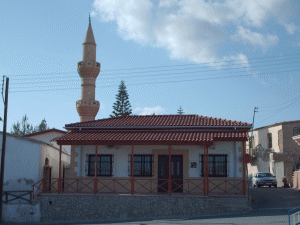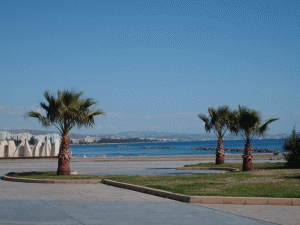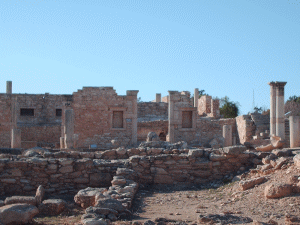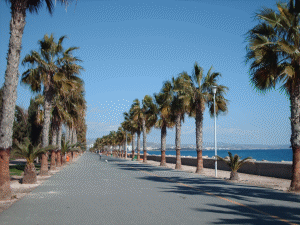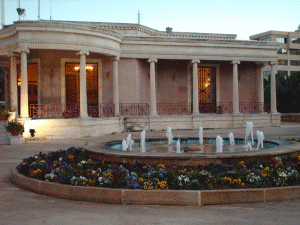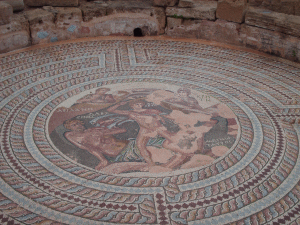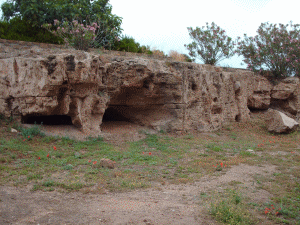About Cyprus - Overview
Cyprus is the third largest island in the Mediterranean, and is situated at the crossroads of the continents - Europe, Asia and Africa.
The birth place and home of Aphrodite (according to Greek Mythology), the island is an open air museum, where one can visit prehistoric settlements, classical Greek temples, Roman theatres and villas, Gothic cathedrals, British colonial-style buildings, and much more...
Apart from the archeological goldmine to be discovered, Cyprus also boasts several beaches with calm, crystal clear waters and typical Mediterranean weather all year round.
Click here to find out about Booking a Holiday Apartment / Vacation Property in Larnaca, Cyprus
History
The first signs of permanent settlement in Cyprus date back to the Neolithic age (8200-3800 BC) where people lived in single room dwellings, used stone tools and vessels, and made jewellery out of picrolite.
During the late Bronze age (2600-1000 BC), Cyprus experienced significant development including intensive mining of copper and other metals. In fact, it is alleged that the latin name for copper (cuprum) may have got its name for Cyprus. At this time, there were also commercial ties established with Siria and Egypt, the Aphrodite cult was established in Pafos.
The island then went through the Iron age (1050-750 BC) where copper was gradually replaced with iron in tool making. This was also when the Phoenicians arrived in Cyprus and colonised the large coastal Mycenaean city of Kition.
The next stage, the Archaic period (750-480 BC), was marked by the Assyrian rule, which later passed on to the Egyptians under Pharaoh Amasis, and eventually to the Persians.
During the Hellenistic period (325-58 BC), civil war broke out throughout Cyprus and that was the period when Alexandra the Great died, and Tolomeo I took over control of the Island. This lead to the Roman period in 58 BC which brought about the conversion of Cyprus to a senatorial province.
Between the years 313 and 1191, Christianism was declared the official religion of the empire which was followed by a various earthquakes that destroyed Pafos and Salamina.
Geography
An island 95km wide and 240km long with a surface area of 9.828 square kilometers, Cyprus has 4 main topographic regions: the forest mountains of Troodos, the arid mountains of Troodos in the south, the Kyrenia mountains in the north, and the flat planes of Mesaoria.
Cyprus has 768km of coastline ranging from rocky to sandy beaches. Some of the beaches have darker sand owing to the volcanic Troodos region, while the golden and white sandy beaches lie in the east of the island. The coastal terrain in the south is quite abrupt forming splendid white cliffs with beaches at their feet and near Limassol and Famagusta, the sea bed inclines to form deep natural ports.
The Troodos area is ideal for the formation of clouds, trapping winds that arrive mainly from the west. The Troodos is also the source from which spring the main rivers in Cyprus whose water is stored for use throughout the year.
Climate
The two mountain areas on the island have a considerable impact on the climate, and the high levels of sun generate a notable difference in temperature between the coast and inland areas. The coast is normally cooler in summer and milder in winter than the inland areas.
Classified as "dry mediterranean" weather, Cyprus shows big seasonal differences. Summers (june to september) are dry and hot, while winters (november to february/march) are variable, and these two seasons are separated by very brief spring and autumn months.
Get the weather forecast for the current week in CyprusThe table below shows the general average temperatures and humidity throughout the year in Cyprus.
| Month | Max Daily Coastal Temp (°C) |
Min Nightly Coastal Temp (°C) | Mean Daily Sunshine (Hours) | Sea Temp (°C) |
Humidity (%) | Raindays |
| Jan | 16 | 8 | 5 | 17 | 70 | 9 |
| Feb | 17 | 8 | 6 | 17 | 69 | 7 |
| Mar | 18 | 9 | 7 | 18 | 65 | 5 |
| Apr | 22 | 12 | 9 | 20 | 67 | 3 |
| May | 26 | 16 | 10 | 21 | 68 | 3 |
| Jun | 30 | 18 | 12 | 24 | 64 | 1 |
| Jul | 32 | 21 | 12 | 26 | 60 | 1 |
| Aug | 33 | 22 | 12 | 27 | 61 | 1 |
| Sep | 31 | 20 | 11 | 26 | 59 | 1 |
| Oct | 27 | 16 | 9 | 24 | 64 | 3 |
| Nov | 22 | 13 | 6 | 21 | 68 | 4 |
| Dec | 18 | 9 | 6 | 19 | 70 | 8 |
